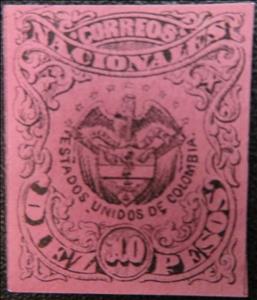Stamp: Coat of Arms (Colombia 1886)
Coat of Arms (Colombia 1886)
01 January (Colombia ) within release 1883/1886 Definitives: Coats of Arms goes into circulation Stamp Coat of Arms face value 10 Colombian peso
| Stamp Coat of Arms in catalogues | |
|---|---|
| Michel: | Mi: CO 88B |
Stamp is square format.
Printed using the twice redrawn plate of MI nr.53 and 65. Official release is doubtful.Also in the issue 1883/1886 Definitives: Coats of Arms:
- Stamp - Coat of Arms face value 10;
- Stamp - Coat of Arms face value 10;
- Stamp - Coat of Arms face value 5;
- Stamp - Coat of Arms face value 5;
- Stamp - Coat of Arms face value 10;
- Stamp - Coat of Arms face value 5;
- Stamp - Coat of Arms face value 5;
Stamp Coat of Arms it reflects the thematic directions:
Animals are multicellular, eukaryotic organisms of the kingdom Animalia (also called Metazoa). All animals are motile, meaning they can move spontaneously and independently, at some point in their lives. Their body plan eventually becomes fixed as they develop, although some undergo a process of metamorphosis later on in their lives. All animals are heterotrophs: they must ingest other organisms or their products for sustenance.
Birds (Aves), a subgroup of Reptiles, are the last living examples of Dinosaurs. They are a group of endothermic vertebrates, characterised by feathers, toothless beaked jaws, the laying of hard-shelled eggs, a high metabolic rate, a four-chambered heart, and a strong yet lightweight skeleton. Birds live worldwide and range in size from the 5 cm (2 in) bee hummingbird to the 2.75 m (9 ft) ostrich. They rank as the class of tetrapods with the most living species, at approximately ten thousand, with more than half of these being passerines, sometimes known as perching birds. Birds are the closest living relatives of crocodilians.
A coat of arms is an heraldic visual design on an escutcheon (i.e. shield), surcoat, or tabard. The coat of arms on an escutcheon forms the central element of the full heraldic achievement which in its whole consists of shield, supporters, crest, and motto. A coat of arms is traditionally unique to an individual person, family (except in the United Kingdom), state, organisation or corporation.




